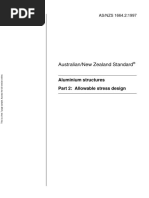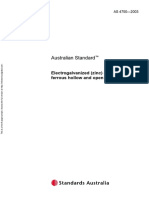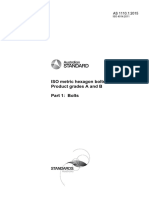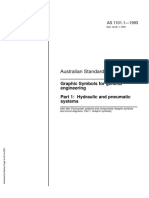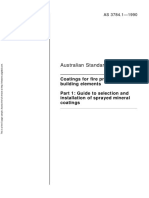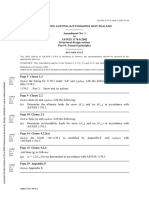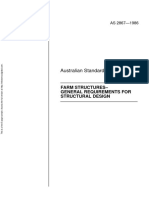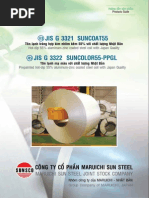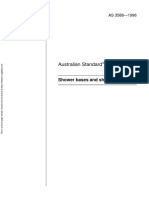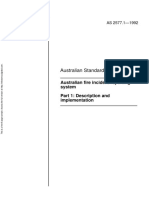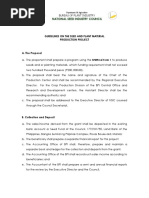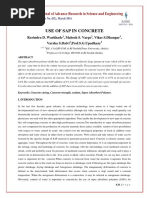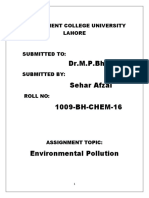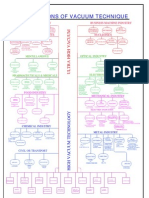1664
1664
Uploaded by
engineer.mmCopyright:
Available Formats
1664
1664
Uploaded by
engineer.mmCopyright
Available Formats
Share this document
Did you find this document useful?
Is this content inappropriate?
Copyright:
Available Formats
1664
1664
Uploaded by
engineer.mmCopyright:
Available Formats
AS 16641979
This is a free 6 page sample. Access the full version online.
Australian Standard
SAA Aluminium Structures Code
The following scientific, industrial and governmental organizations and departments
were officially represented on the committee entrusted with the preparation of this
standard:
Aluminium Development Council
Department of Labour and Industry, N.S.W.
Department of Public Works, N.S.W.
National Association of Australian State Roads Authorities
This is a free 6 page sample. Access the full version online.
Railways of Australia Committee
This standard, prepared by Committee BD/50, Aluminium Structures, was approved
on behalf of the Council of the Standards Association of Australia on 9 March 1979,
and was published on 1 June 1979.
The rules are intended to include the technical provisions necessary for design and
fabrication of aluminium alloy load-carrying members, but do not purport to comprise
all the necessary provisions of a contract.
Review of Australian Standards. To keep abreast of progress in industry, Australian Standards are subject
to periodic review and are kept up to date by the issue of amendments or new editions as necessary. It is
important therefore that Standards users ensure that they are in possession of the latest ed ition, and any
amendments thereto.
Full details of all Australian Standards and related publications will be found in the Standards Australia
Catalogue of Publications; this information is supplemented each month by the magazine The Australian
Standard, which subscribing members receive, and which gives details of new publications, new editions
and amendments, and of withdrawn Standards.
Suggestions for improvements to Australian Standards, addressed to the head office of Standards Australia,
are welcomed. Notification of any inaccuracy or ambiguity found in an Australian Standard should be made
without delay in order that the matter may be investigated and appropriate action taken.
AS 16641979
This is a free 6 page sample. Access the full version online.
Australian Standard
RULES FOR
THE USE OF ALUMINIUM IN
STRUCTURES
known as the
SAA ALUMINIUM STRUCTURES
CODE
First published . . . . . . . . . . . . . . . . . . . . . . . .
Revised . . . . . . . . . . . . . . . . . . . . . . . . . . . . .
1975
1979
Incorporating:
Interp 1 1985
PUBLISHED BY STANDARDS AUSTRALIA
(STANDARDS ASSOCIATION OF AUSTRALIA)
1 THE CRESCENT, HOMEBUSH, NSW 2140
ISBN 0 7262 0567 2
AS 16641979
This is a free 6 page sample. Access the full version online.
PREFACE
This standard, which is a revision of AS 16641975
was prepared by the Associations Committee on
Aluminium Structures. It is based on the Aluminium
Construction ManualSection 1: Specifications for
Aluminium Structures (2nd Ed. 1971) published by
the Aluminium Association, New York and British
Standard CP 1181969, The Structural Use of
Aluminium. The committee gratefully acknowledges
the assistance received from these sources.
In the revision the principal changes have related
to data on the range of aluminium alloys which has
been generally extended. The standard does not now
provide for alloy Alclad 3004 in H16 temper.
The standard applies to the design and
fabrication of aluminium structures and is presented
in a similar format to AS 1250, SAA Steel Structures
Code; however it is emphasized that steel designs
should not be directly copied as many types of
welded connections used in steel fabrication are
entirely unsuitable for aluminium structures. For
welded aluminium structures particular attention shall
be given to the design of welded connections and the
possibility of failure of members by local buckling.
The committee has recommended that the
international designation system for wrought
aluminium and aluminium alloys used by the
Aluminium Development Council (ADC) be adopted
for all Australian standards. This designation system
is used throughout this standard and a detailed
explanation of the system can be found in the ADC
publication Aluminium Standards and DataThird
Edition.
The design sections of the standard (Section 5,
Maximum Permissible Stresses, and Section 6,
Combined Stresses) consist of a compilation of
methods to determine the maximum permissible
stresses for different types and combinations of
stress. The maximum permissible stresses for alloys
commonly used in structures are given in Tables A1
to A21 in Appendix A.
Aluminium alloys attain their strengths by heat
treatment or strain hardening, and welding causes
local overageing or annealing in heat-treatable and
non-heat-treatable alloys respectively, producing a
zone of lower strength along both sides of the weld
bead. To account for this decrease in strength,
permissible stresses for welded members are
determined as outlined in Rule 5.3.3.
Attention is drawn to the following Australian,
American and British standards and other documents
which may be required for use in connection with this
standard:
AS 1110
ISO Metric Hexagon Precision
Bolts and Screws
AS 1111
ISO Metric Hexagon Commercial
Bolts and Screws
AS 1112
ISO Metric Hexagon Nuts,
Including Thin Nuts, Slotted Nuts
and Castle Nuts
AS 1170
SAA Loading Code
Part 1Dead and Live Loads
Part 2Wind Forces
AS 1237
Flat Metal Washers for General
Engineering Purposes (Metric
Series)
AS 1250
AS 1275
SAA Steel Structures Code
Metric Screw Threads for
Fasteners (Based on ISO
Recommendations)
AS 1418
SAA Crane Code
AS 1449
Stainless and Heat-resisting Steel
Plate, Sheet and Strip (Coils and
Cut Lengths)
AS 1480
SAA Concrete Structures Code
AS 1511
SAA High-strength Structural
Bolting Code
AS 1538
SAA Cold-formed Steel
Structures Code
AS 1562
Code of Practice for the Design
and Instal lati on of Selfsupporti ng Met al R oofi ng
Without Transverse Laps
AS 1588
Filler Rods for Welding
AS 1627
Code of Practice for Preparation
and Pretreatment of Metal
Surfaces Prior to Protective
Coating
Part 1Degreasing of Metal
Surfaces Using Solvent or
Alkaline Solutions
AS 1665
SAA Aluminium Welding Code
AS 1734
Wrought Aluminium and
Aluminium Alloy Flat Sheet,
Coiled Sheet and Plate for
General Engineering Purposes
AS 1735
SAA Lift Code
AS 1866
Wrought Aluminium and
Aluminium Alloy Extruded Rod,
Bar, Solid Tubes and Hollow
Shapes for General Engineering
Purposes
AS 1867
Wrought Aluminium and
Aluminium Alloy Drawn Tubes
for General Engineering Purposes
AS K108
Metal Priming Paint, Anticorrosive
ASTM D 962 Specification for Aluminium
Pigments, Powder and Paste, for
Paints
U.S.A.
Federal Government
Specification TT-V-81F: Varnish,
Mixing for Aluminium Paints
BS 641
Dimensions of Small Rivets for
General Purposes
BS 1974
Large Aluminium Alloy Rivets:
1/2 in to 1 in Nominal Diameters
BS 2708
Unified Black Square and
Hexagon Bolts, Screws and Nuts
( U N C
a n d
U N F
Threads)Normal Series
BS CP118
The Structural Use of Aluminium
Aluminium Technology*
Book 2Forming Aluminium
Book 3Machining Aluminium
Book 4Joining Aluminium
* Published by Aluminium Development Council.
AS 16641979
CONTENTS
Page
SECTION
1.1
1.2
1.3
1.4
1.5
1.6
1. GENERAL
Scope . . . . . . . . . . . . . . .
Standards . . . . . . . . . . . .
New Materials or Methods
Design and Supervision . .
Definitions . . . . . . . . . . .
Notation . . . . . . . . . . . . .
SECTION
2.1
2.2
2.3
2. MATERIALS
Aluminium Alloys . . . . . . . . . . . . .
Fasteners and Filler Rods . . . . . . . .
Mechanical Properties of Aluminium
Alloys . . . . . . . . . . . . . . . . . . . . .
Buckling Constants . . . . . . . . . . . .
Steel . . . . . . . . . . . . . . . . . . . . . .
Concrete . . . . . . . . . . . . . . . . . . . .
This is a free 6 page sample. Access the full version online.
2.4
2.5
2.6
.
.
.
.
.
.
.
.
.
.
.
.
.
.
.
.
.
.
.
.
.
.
.
.
.
.
.
.
.
.
.
.
.
.
.
.
.
.
.
.
.
.
.
.
.
.
.
.
.
.
.
.
.
.
.
.
.
.
.
.
4
4
4
4
4
4
...
...
7
7
.
.
.
.
8
8
8
8
.
.
.
.
.
.
.
.
SECTION
3.1
3.2
3.3
3.4
3. GENERAL DESIGN REQUIREMENTS
Loads . . . . . . . . . . . . . . . . . . . . . . . . 14
Design . . . . . . . . . . . . . . . . . . . . . . . 14
Experimentally Based Designs . . . . . . 15
Weld Quality in Welded Structures . . . 15
SECTION
4.1
4.2
4.3
4.4
4. GEOMETRICAL PROPERTIES
Gross Section . . . . . . . . . . . . . . .
Effective Section . . . . . . . . . . . . .
Hole Effective Diameters . . . . . . .
Sectional Areas of Bolts and Rivets
SECTION
5.1
5.2
5.3
5.4
5.5
5. MAXIMUM PERMISSIBLE STRESSES
General . . . . . . . . . . . . . . . . . . . . . . 17
Minimum Mechanical Properties . . . . . 17
Maximum Permissible Stresses . . . . . . 17
Design Details . . . . . . . . . . . . . . . . . 26
Compression in Single Web Laterally
Unbraced Beams . . . . . . . . . . . . . . . . 27
Special Provisions for Thin Sections . . 27
5.6
SECTION
6.1
6.2
6.3
6.4
...
...
...
..
6. COMBINED STRESSES
General . . . . . . . . . . . . . . . . . . . .
Combined Compression and Bending
Combined Shear, Compression and
Bending . . . . . . . . . . . . . . . . . . . .
Torsion and Shear in Tubes . . . . . .
SECTION 7. DESIGN OF CONNECTIONS
7.1
Arrangements and Strength of
Connections . . . . . . . . . . . . . . .
7.2
Maximum Permissible Forces on
Rivets and Bolts . . . . . . . . . . . .
7.3
Design Details . . . . . . . . . . . . .
7.4
Alternative Fasteners . . . . . . . . .
16
16
16
16
..
..
30
30
..
..
30
30
....
31
....
....
....
31
31
32
Page
SECTION
8.1
8.2
8.3
8.4
8.5
8.6
8.7
8. FABRICATION
Laying Out . . . . . . . . . . . . . . .
Cutting . . . . . . . . . . . . . . . . . .
Heating . . . . . . . . . . . . . . . . .
Punching, Drilling and Reaming
Bolting . . . . . . . . . . . . . . . . . .
Riveting . . . . . . . . . . . . . . . . .
Welded Structures . . . . . . . . . .
SECTION
9.1
9.2
9.3
9. PAINTING
General . . . . . . . . . . . . . . . . . . . . . .
Contact with Dissimilar Materials . . . .
Cleaning and Treatment of Metal
Surfaces . . . . . . . . . . . . . . . . . . . . . .
APPENDICES
A Maximum Permissible Stresses for
Aluminium Sections . . . . . . . . . .
B Fatigue . . . . . . . . . . . . . . . . . . .
C Struts . . . . . . . . . . . . . . . . . . . . .
D Constants for Lateral Buckling
of Beams . . . . . . . . . . . . . . . . . .
E References on the Elastic Flexural/
Torsional Buckling of Beams . . . .
.
.
.
.
.
.
.
.
.
.
.
.
.
.
.
.
.
.
.
.
.
.
.
.
.
.
.
.
.
.
.
.
.
.
.
.....
.....
.....
33
33
33
33
33
33
33
34
34
34
35
78
96
. . . . . 100
. . . . . 103
TABLES
1. Aluminium Filler Alloys for General
Purpose Welding . . . . . . . . . . . . . . . . . . . 7
2. Minimum Mechanical Properties for
Aluminium Alloys . . . . . . . . . . . . . . . . . 8
3. Minimum Mechanical Properties for
Welded Aluminium Alloys . . . . . . . . . . . . 9
4. Formulas for Buckling Constants:
For Products Temper Designations O,
T1, T3, or T4 and Temper Designations
beginning with H . . . . . . . . . . . . . . . . . 10
5. Formulas for Buckling Constants:
For Products Temper Designations T5,
T6, T8, or T9 . . . . . . . . . . . . . . . . . . . . 11
6. Buckling Formula Constants for
Non-welded Aluminium Alloys . . . . . . . 12
7. Factors of Safety for Buildings and
Similar Structures . . . . . . . . . . . . . . . . . 14
8. Values of Coefficients kt and k c . . . . . . . 17
9. General Formulas for Determining
Maximum Permissible Stresses . . . . . . . . 22
10. Maximum Permissible Shear Stresses
in Fillet Welds . . . . . . . . . . . . . . . . . . . 24
11. Maximum Permissible Bearing Stresses . . 31
12. Maximum Permissible Shear Stresses in
Rivets . . . . . . . . . . . . . . . . . . . . . . . . . 31
13. Maximum Permissible Stresses in Bolts . 31
Copyright STANDARDS AUSTRALIA
Users of Standards are reminded that copyright subsists in all Standards Australia publications and software. Except where the
Copyright Act allows and except where provided for below no publications or software produced by Standards Australia may be
reproduced, stored in a retrieval system in any form or transmitted by any means without prior permission in writing from
Standards Australia. Permission may be conditional on an appropriate royalty payment. Requests for permission and information on
commercial software royalties should be directed to the head office of Standards Australia.
Standards Australia will permit up to 10 percent of the technical content pages of a Standard to be copied for use
exclusively in-house by purchasers of the Standard without payment of a royalty or advice to Standards Australia.
Standards Australia will also permit the inclusion of its copyright material in computer software programs for no royalty
payment provided such programs are used exclusively in-house by the creators of the programs.
Care should be taken to ensure that material used is from the current edition of the Standard and that it is updated whenever the
Standard is amended or revised. The number and date of the Standard should therefore be clearly identified.
The use of material in print form or in computer software programs to be used commercially, with or without payment, or in
commercial contracts is subject to the payment of a royalty. This policy may be varied by Standards Australia at any time.
AS 16641979
STANDARDS ASSOCIATION OF AUSTRALIA
Australian Standard Rules
for
THE USE OF ALUMINIUM IN STRUCTURES
This is a free 6 page sample. Access the full version online.
SECTION 1. GENERAL
1.1 SCOPE. These Rules (hereinafter referred to as this
Code) apply to the design and fabrication of aluminium
alloy load-carrying members.
1.2 STANDARDS. Unless otherwise noted, a Standard
referred to in this Code is the current edition thereof.
1.3 NEW MATERIALS OR METHODS. This Code
shall not be interpreted to prevent the use of materials,
methods of design or construction not specifically
referred to herein. If it is desired to seek the opinion of
the SAA Committee on Aluminium Structures as to
whether materials other than those specified, or methods
of design or construction not covered herein, are deemed
to comply with the intention of this Code, details of
such materials or methods, including relevant test
results, shall be submitted to the Committee.
NOTE: It will be necessary to seek approval from the appropriate
Authority for the use of new materials or methods.
1.4 DESIGN AND SUPERVISION.
1.4.1 Design. The design of a structure or the part of a
structure to which this Code is applied shall be the
responsibility of an engineer experienced in the design
of such structures.
For the purpose of this Code the term Design Engineer
shall mean the engineer responsible for design and shall
include his representative.
1.4.2 Supervision. All stages of construction of a
structure or the part of a structure to which this Code is
applied shall be adequately supervised to ensure that all
the requirements of the design are satisfied in the
completed structure, the supervision being the
responsibility of either
(a) the design engineer, or
(b) an engineer experienced in such supervision.
For the purposes of this Code, the term Supervising
Engineer shall mean the engineer responsible for
supervision of construction and shall include his
representative.
NOTE: Although the execution of design and supervision may be
delegated to other acceptable persons who need not necessarily be
qualified, Rule 1.4 requires that design and supervision must be the
responsibility of qualified and experienced persons.
Similarly, the Rule does not require the design engineer to be
responsible for supervision also unless he has been assigned this
responsibility specifically. The design engineer and the supervising
engineer need not be the same person.
1.5 DEFINITIONS.
1.5.1 General. For the purpose of this Code, the
definitions in Rules 1.5.2 and 1.5.3 shall apply.
NOTE: Other terms having special meanings are defined in the
Rule in which they occur.
Authority - a body having statutory powers to control
the design and erection of buildings or structures in
the area in which the building or structure
concerned is to be erected.
Contractor - the person, persons or organization
agreeing under a contract to execute the work.
Engineer - a person qualified for Corporate Membership
of the Institution of Engineers, Australia (see
Rule 1.4).
NOTE: This definition does not require that an engineer be a
Corporate Member of the Institution of Engineers, Australia.
1.5.3 Technical Definitions.
Beam or girder - a structural member, other than a
triangulated frame, which supports load primarily
by its internal resistance to bending.
Dead load - the actual mass of all permanent
construction and all permanently installed plant,
equipment, and services required for functional
purposes.
Earthquake forces - all forces on a structure caused by
earthquakes.
Gauge - the transverse spacing between parallel adjacent
lines of fasteners.
Live load - the load assumed to arise from the intended
use or purpose of a structure, including distributed,
concentrated, impact and inertial forces, but
excluding wind, snow and earthquake forces.
Pitch - the centre distance between individual fasteners
in a line of fasteners.
Strut - a compression member including a column or
stanchion.
Wind forces - all forces on a structure caused by wind
pressure.
1.6 NOTATION. The notation used in any of the Rules
of this Code shall have the following meanings with
respect to the structure, or member or condition to
which the Rule is applied, unless otherwise defined
elsewhere in this Code. Unless otherwise stated, a
dimension shall mean a specified dimension.
(a) Maximum permissible stresses.
= the maximum permissible compressive
Fac
stress in an axially loaded strut not
subjected to bending
Fat
Fbc
1.5.2 Administrative Definitions.
Approved - according to the context, approved either by
the Engineer or the appropriate Authority.
Fbt
= the maximum permissible tensile stress
in an axially loaded tension member not
subjected to bending
= the maximum permissible compressive
stress due to bending in a member not
subjected to axial force
= the maximum permissible tensile stress
due to bending in a member not
subjected to axial force
This is a free preview. Purchase the entire publication at the link below:
This is a free 6 page sample. Access the full version online.
AS 1664-1979 Rules for the use of aluminium in
structures (known as the SAA Aluminium
Structures Code) (incorporating Corrig.)
Looking for additional Standards? Visit SAI Global Infostore
Subscribe to our Free Newsletters about Australian Standards in Legislation; ISO, IEC, BSI and more
Do you need to Manage Standards Collections Online?
Learn about LexConnect, All Jurisdictions, Standards referenced in Australian legislation
Do you want to know when a Standard has changed?
Want to become an SAI Global Standards Sales Affiliate?
Learn about other SAI Global Services:
LOGICOM Military Parts and Supplier Database
Metals Infobase Database of Metal Grades, Standards and Manufacturers
Materials Infobase Database of Materials, Standards and Suppliers
Database of European Law, CELEX and Court Decisions
Need to speak with a Customer Service Representative - Contact Us
You might also like
- ASNZS3679.2-2016 Structural Steel - Part 2 Welded I SectionsDocument38 pagesASNZS3679.2-2016 Structural Steel - Part 2 Welded I Sectionsvajahatullahkhan100% (1)
- As-NZS 1252.1-2016 High-Strength Steel Fastener Assemblies For Structural EngineeringDocument56 pagesAs-NZS 1252.1-2016 High-Strength Steel Fastener Assemblies For Structural EngineeringRoan Chua100% (1)
- 化学成分表Document1 page化学成分表Duy NguyenNo ratings yet
- NZS 1664-1-1997 Aluminium Structures Limit State Design PDFDocument8 pagesNZS 1664-1-1997 Aluminium Structures Limit State Design PDFlaiju p b0% (2)
- MEMBRANES Installation Instructions To AS 42002 V1222Document43 pagesMEMBRANES Installation Instructions To AS 42002 V1222Stephen MaartenszNo ratings yet
- Australian/New Zealand Standard: Structural Design Actions Part 0: General PrinciplesDocument8 pagesAustralian/New Zealand Standard: Structural Design Actions Part 0: General PrinciplesMikeChan0% (4)
- As 1163 - Hollow Sections For Structural SteelDocument26 pagesAs 1163 - Hollow Sections For Structural SteelIrene Yu100% (1)
- As3678 2011Document41 pagesAs3678 2011Billy Brikz Yanis100% (1)
- Triton RTA200 SparesDocument2 pagesTriton RTA200 Sparesj_abendstern4688No ratings yet
- As 4912-2002 (Reference Use Only) General Conditions of Contract For The Periodic Supply of GoodsDocument7 pagesAs 4912-2002 (Reference Use Only) General Conditions of Contract For The Periodic Supply of GoodsSAI Global - APACNo ratings yet
- Australian/New Zealand Standard: Aluminium Structures Part 2: Allowable Stress DesignDocument8 pagesAustralian/New Zealand Standard: Aluminium Structures Part 2: Allowable Stress DesignSiddhant Agarwal100% (1)
- As 4750-2003 Electrogalvanized (Zinc) Coatings On Ferrous Hollow and Open SectionsDocument7 pagesAs 4750-2003 Electrogalvanized (Zinc) Coatings On Ferrous Hollow and Open SectionsSAI Global - APACNo ratings yet
- AS 1554 Part 3 Welding Reinforcing SteelDocument29 pagesAS 1554 Part 3 Welding Reinforcing SteelCarlos Velilla MNo ratings yet
- As 3826-1998 Strengthening Existing Buildings For EarthquakeDocument7 pagesAs 3826-1998 Strengthening Existing Buildings For EarthquakeSAI Global - APACNo ratings yet
- AS 1275-1985 Metric Screw Threads For FastnersDocument20 pagesAS 1275-1985 Metric Screw Threads For Fastnersnolan.melhartNo ratings yet
- As 1391-2007 (+a1)Document8 pagesAs 1391-2007 (+a1)Tuan DangNo ratings yet
- As 2334-1980 Steel Nails - Metric SeriesDocument7 pagesAs 2334-1980 Steel Nails - Metric SeriesSAI Global - APACNo ratings yet
- (1-2) and 1111. (1-2) - 2015 - ISO Meteric Hexagon Bolts and ScrewsDocument88 pages(1-2) and 1111. (1-2) - 2015 - ISO Meteric Hexagon Bolts and ScrewsMark Carroll-ChiltsNo ratings yet
- Welding Consumables and Design of Welds in AS 4100-1998 WITH AMENDMENT 1, 2012Document6 pagesWelding Consumables and Design of Welds in AS 4100-1998 WITH AMENDMENT 1, 2012fmboy700100% (1)
- As 1397-2001 Steel Sheet and Strip - Hot-Dipped Zinc-Coated or Aluminium Zinc-CoatedDocument7 pagesAs 1397-2001 Steel Sheet and Strip - Hot-Dipped Zinc-Coated or Aluminium Zinc-CoatedSAI Global - APAC0% (2)
- SAI GLOBAL, Index House, Ascot, Berks, SL5 7EU, UKDocument29 pagesSAI GLOBAL, Index House, Ascot, Berks, SL5 7EU, UKtracyhopyNo ratings yet
- As Nzs 1252 1996Document29 pagesAs Nzs 1252 1996Khan NiNo ratings yet
- ColdSteel Manual V120Document87 pagesColdSteel Manual V120Terry CheukNo ratings yet
- Australian Standard: Guidelines For The Erection of Building SteelworkDocument0 pagesAustralian Standard: Guidelines For The Erection of Building SteelworkZoran MatevNo ratings yet
- Australian/New Zealand StandardDocument8 pagesAustralian/New Zealand Standardcris0% (1)
- ASI National Structural Steelwork Specification V2 Final PDFDocument44 pagesASI National Structural Steelwork Specification V2 Final PDFSamsuNo ratings yet
- High Strength Structural Bolt Assemblies To As/nzs 1252Document4 pagesHigh Strength Structural Bolt Assemblies To As/nzs 1252Josh Maizidian100% (1)
- CCEC Standards Regulations Guide ENDocument9 pagesCCEC Standards Regulations Guide ENHeru Pribadi100% (1)
- AS 1101.3 - 1987 Graphical Symbols For Engineering - WeldingDocument44 pagesAS 1101.3 - 1987 Graphical Symbols For Engineering - WeldingRobart JacobNo ratings yet
- As Standard ListDocument6 pagesAs Standard ListNguyen Duc DungNo ratings yet
- 1390-1997 Cup Head Bolts With ISO Metric Coarse Pitch ThreadsDocument19 pages1390-1997 Cup Head Bolts With ISO Metric Coarse Pitch ThreadsSean LiongNo ratings yet
- AS 4652.2 1012 Waterproofing Membranes For ExternalDocument6 pagesAS 4652.2 1012 Waterproofing Membranes For ExternalHaisen QinNo ratings yet
- As 3784.1-1990 Coatings For Fire Protection of Building Elements Guide To Selection and Installation of SprayDocument6 pagesAs 3784.1-1990 Coatings For Fire Protection of Building Elements Guide To Selection and Installation of SpraySAI Global - APACNo ratings yet
- BS 709Document17 pagesBS 709vuthuy94No ratings yet
- NZS 3404 (2009) Steel Structures Standard (Materials, Fabrication and Construction)Document163 pagesNZS 3404 (2009) Steel Structures Standard (Materials, Fabrication and Construction)Ba Thanh DinhNo ratings yet
- Previews-ANSI Z97!1!2009 PreDocument12 pagesPreviews-ANSI Z97!1!2009 PreMetzy Nieto SanchezNo ratings yet
- As 3996-2006 Access Covers and GratesDocument7 pagesAs 3996-2006 Access Covers and GratesSAI Global - APACNo ratings yet
- As 4600 Rel NoteDocument14 pagesAs 4600 Rel NoteDiana Ho WyNo ratings yet
- As 3750.18-2002 Paints For Steel Structures Moisture Cure Urethane (Single-Pack) SystemsDocument7 pagesAs 3750.18-2002 Paints For Steel Structures Moisture Cure Urethane (Single-Pack) SystemsSAI Global - APACNo ratings yet
- AS 4676-2000 UtilityPoleDesign PDFDocument8 pagesAS 4676-2000 UtilityPoleDesign PDFBert66Lim0% (1)
- Expansion Joints Seals Brochure Issue 03Document16 pagesExpansion Joints Seals Brochure Issue 03Andrew PetryszakNo ratings yet
- AS4055-1192 Wind Loads For HousingDocument24 pagesAS4055-1192 Wind Loads For Housingdipyaman_19No ratings yet
- As 4100-1998 Steel StructuresDocument11 pagesAs 4100-1998 Steel StructuresSAI Global - APAC0% (6)
- As 1111.1-2000 ISO Metric Hexagon Bolts and Screws - Product Grade C BoltsDocument10 pagesAs 1111.1-2000 ISO Metric Hexagon Bolts and Screws - Product Grade C BoltsSAI Global - APACNo ratings yet
- As 1170 (1) .0-2002 Amdt 1-2003 Structural Design Actions - General PrinciplesDocument1 pageAs 1170 (1) .0-2002 Amdt 1-2003 Structural Design Actions - General PrinciplesDrRat P RatanamalayaNo ratings yet
- Bolt ConnectionsDocument32 pagesBolt ConnectionsMatthew JohnstonNo ratings yet
- As 2867-1986 Farm Structures - General Requirements For Structural DesignDocument6 pagesAs 2867-1986 Farm Structures - General Requirements For Structural DesignSAI Global - APAC100% (1)
- AS 1735.1-2003 General RequirementsDocument48 pagesAS 1735.1-2003 General RequirementsMorten Pedersen100% (1)
- Ton Lanh Mau-Theo JIS 3322Document5 pagesTon Lanh Mau-Theo JIS 3322mrphongvnctNo ratings yet
- Australian StandardDocument33 pagesAustralian StandardJohn RainbirdNo ratings yet
- Australian/New Zealand StandardDocument36 pagesAustralian/New Zealand StandardKako DaNo ratings yet
- AS0908.2 (2000) Cellulose - Cement Products - Flat SheetsDocument22 pagesAS0908.2 (2000) Cellulose - Cement Products - Flat Sheetsjojo351No ratings yet
- As 3588-1996 Shower Bases and Shower ModulesDocument7 pagesAs 3588-1996 Shower Bases and Shower ModulesSAI Global - APACNo ratings yet
- Staad As4100Document28 pagesStaad As4100Amir IskandarNo ratings yet
- As 3495-1997 Authorization Requirements For Plumbing Products - Stainless Steel Non-Pressure Pipes and FittinDocument7 pagesAs 3495-1997 Authorization Requirements For Plumbing Products - Stainless Steel Non-Pressure Pipes and FittinSAI Global - APACNo ratings yet
- As 2577.1-1992 Australian Fire Incident Reporting System Description and ImplementationDocument7 pagesAs 2577.1-1992 Australian Fire Incident Reporting System Description and ImplementationSAI Global - APACNo ratings yet
- Gang-Nail Systems LTD: Top/C BTM/C WEB Wedge Member Grade DepthDocument9 pagesGang-Nail Systems LTD: Top/C BTM/C WEB Wedge Member Grade DepthcetinidrisNo ratings yet
- 4100 1998 - A1 2012Document30 pages4100 1998 - A1 2012Farid TataNo ratings yet
- 10210-10219 - Hollow SectDocument2 pages10210-10219 - Hollow SectBenedictus MurdonoNo ratings yet
- MP01P17Document16 pagesMP01P17MD Francis DuqmNo ratings yet
- Australian Standard: Design of Steel Lattice Towers and MastsDocument7 pagesAustralian Standard: Design of Steel Lattice Towers and Mastsalsager14No ratings yet
- Square and Rectangular HSS and Box-Shaped Members: Material Proper TiesDocument2 pagesSquare and Rectangular HSS and Box-Shaped Members: Material Proper Tiesengineer.mmNo ratings yet
- BL01Document1 pageBL01engineer.mmNo ratings yet
- 01 Ati AtihanDocument1 page01 Ati Atihanengineer.mmNo ratings yet
- SYP BrochureDocument38 pagesSYP Brochureengineer.mmNo ratings yet
- Robert Horne - Skybond Original Technical SheetsDocument1 pageRobert Horne - Skybond Original Technical Sheetsengineer.mmNo ratings yet
- Guidelines SeedplntmtrlDocument2 pagesGuidelines Seedplntmtrlengineer.mmNo ratings yet
- Z App. B.5 - ReactionsDocument1 pageZ App. B.5 - Reactionsengineer.mmNo ratings yet
- AISC Design Guide 1 Table 3.2 PDFDocument1 pageAISC Design Guide 1 Table 3.2 PDFamine ayari100% (1)
- LL LL: Uj Uj Uj I-Cfj (Cfji (1) 0 CyDocument1 pageLL LL: Uj Uj Uj I-Cfj (Cfji (1) 0 Cyengineer.mmNo ratings yet
- Technical Bulletin 11 1-8-30 11Document2 pagesTechnical Bulletin 11 1-8-30 11engineer.mmNo ratings yet
- Anchoring SystemsDocument63 pagesAnchoring Systemsengineer.mmNo ratings yet
- GLASS DESIGN - Monolithic Vision GlassDocument2 pagesGLASS DESIGN - Monolithic Vision Glassengineer.mmNo ratings yet
- NO T To Be Us Edf or PR Ofessi Onal Design Purposes.: Optima - 1 Gen - Alum 12.5 FT L Level52Document1 pageNO T To Be Us Edf or PR Ofessi Onal Design Purposes.: Optima - 1 Gen - Alum 12.5 FT L Level52engineer.mmNo ratings yet
- Materials and Design: Bekir Sadık Ünlü, Enver Atik, Sinan KöksalDocument5 pagesMaterials and Design: Bekir Sadık Ünlü, Enver Atik, Sinan KöksalVinay GopalNo ratings yet
- Mole ConceptDocument17 pagesMole ConceptRaju SinghNo ratings yet
- 06.7. Epd Ass 70 FD Sf2aDocument12 pages06.7. Epd Ass 70 FD Sf2aMoustafaNo ratings yet
- Puritan Medical SwabsDocument8 pagesPuritan Medical SwabsJuan Diego Zutta ArcosNo ratings yet
- CEE 9571 - Advanced Concrete TechnologyDocument3 pagesCEE 9571 - Advanced Concrete TechnologyabimalainNo ratings yet
- Artificial Retina Using Thin Film Transistors: Presented by Y.Mounisha 12W51A04A0Document20 pagesArtificial Retina Using Thin Film Transistors: Presented by Y.Mounisha 12W51A04A0Hemanth KumarNo ratings yet
- Research Paper in SAPDocument6 pagesResearch Paper in SAPMohammad Rahim RahimiNo ratings yet
- Chemistry Chemistry of of Polymers Polymers: Ingenierie Des Materiaux PolymeresDocument16 pagesChemistry Chemistry of of Polymers Polymers: Ingenierie Des Materiaux PolymeresAndri SomantriNo ratings yet
- Week 3 Video QuestionsDocument1 pageWeek 3 Video Questionsapi-254428474No ratings yet
- Entropy and The Second Law of Thermodynamics: Larry Brown Tom HolmeDocument50 pagesEntropy and The Second Law of Thermodynamics: Larry Brown Tom Holmemuhammad ali shakeelNo ratings yet
- Fuel Types Info & Burning StovesDocument33 pagesFuel Types Info & Burning StovesSkilledWizardNo ratings yet
- Washer-Disinfector G 7823 / G 7824: Operating InstructionsDocument56 pagesWasher-Disinfector G 7823 / G 7824: Operating InstructionsRichpleinNo ratings yet
- Five Day - Biochemical Oxygen DemandDocument21 pagesFive Day - Biochemical Oxygen DemandAG-Metal /Tretman Otpadnih Voda/Wastewater TreatmentNo ratings yet
- Genapol Ba 040Document1 pageGenapol Ba 040malek kaanicheNo ratings yet
- Dr.M.P.Bhatti Sehar Afzal 1009-BH-CHEM-16: Government College University LahoreDocument7 pagesDr.M.P.Bhatti Sehar Afzal 1009-BH-CHEM-16: Government College University LahoreAayat MughalNo ratings yet
- Revaluing Mine Waste Rock For Carbon Capture and StorageDocument17 pagesRevaluing Mine Waste Rock For Carbon Capture and StorageDedi Geo SetionoNo ratings yet
- Physical Properties of Some Common Refrigerants Are IndicatedDocument8 pagesPhysical Properties of Some Common Refrigerants Are IndicatedRajeshSekarNo ratings yet
- COMP.ahsbvamdhpDocument6 pagesCOMP.ahsbvamdhpLIYA B RAJENDRANNo ratings yet
- Che - F241 - 1180 - HT - Bits PilaniDocument4 pagesChe - F241 - 1180 - HT - Bits Pilanivan1234No ratings yet
- Exercise - III: Subjective Level-IDocument6 pagesExercise - III: Subjective Level-IRishabh AgarwalNo ratings yet
- 3.6.5 Bi-Metal Kwik-Flex Self-Drilling Screws (Pg. 168-170) - 2Document4 pages3.6.5 Bi-Metal Kwik-Flex Self-Drilling Screws (Pg. 168-170) - 2LauraMilenaHernándezTorresNo ratings yet
- Vapour Barrier NotesDocument46 pagesVapour Barrier NotesJANVI KRISHNo ratings yet
- Vapour Compression SystemDocument24 pagesVapour Compression SystemAbdullah100% (1)
- The Handbook of Hazardous Materials Spills Technology 39. Sodium CyanideDocument22 pagesThe Handbook of Hazardous Materials Spills Technology 39. Sodium CyanideJoelCristobal100% (1)
- Seismic Isolation Systems With Lead Rubber Bearings (LRB)Document9 pagesSeismic Isolation Systems With Lead Rubber Bearings (LRB)evil_jotNo ratings yet
- Advanced Construction Techniques and Materials: Unit 4Document169 pagesAdvanced Construction Techniques and Materials: Unit 4Bharath SrinivasanNo ratings yet
- Applications of Vacuum TechniqueDocument1 pageApplications of Vacuum Techniquesynayak100% (2)
- 9th Class Chemistry Test Paper 6Document1 page9th Class Chemistry Test Paper 6Amna ShakeelNo ratings yet
- Molecular Mechanisms of Ultrafiltration Membrane FoulingDocument10 pagesMolecular Mechanisms of Ultrafiltration Membrane FoulingtehtnicaNo ratings yet










